
A kurgan is a type of tumulus constructed over a grave, often characterized by containing a single human body along with grave vessels, weapons and horses. Originally in use on the Pontic–Caspian steppe, kurgans spread into much of Central Asia and Eastern, Southeast, Western and Northern Europe during the 3rd millennium BC.

The tomb of Tutankhamun, also known by its tomb number, KV62, is the burial place of Tutankhamun, a pharaoh of the Eighteenth Dynasty of ancient Egypt, in the Valley of the Kings. The tomb consists of four chambers and an entrance staircase and corridor. It is smaller and less extensively decorated than other Egyptian royal tombs of its time, and it probably originated as a tomb for a non-royal individual that was adapted for Tutankhamun's use after his premature death. Like other pharaohs, Tutankhamun was buried with a wide variety of funerary objects and personal possessions, such as coffins, furniture, clothing and jewelry, though in the unusually limited space these goods had to be densely packed. Robbers entered the tomb twice in the years immediately following the burial, but Tutankhamun's mummy and most of the burial goods remained intact. The tomb's low position, dug into the floor of the valley, allowed its entrance to be hidden by debris deposited by flooding and tomb construction. Thus, unlike other tombs in the valley, it was not stripped of its valuables during the Third Intermediate Period.
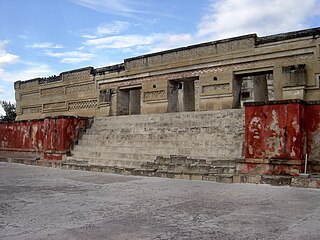
Mitla is the second-most important archeological site in the state of Oaxaca in Mexico, and the most important of the Zapotec culture. The site is located 44 km from the city of Oaxaca, in the upper end of the Tlacolula Valley, one of the three cold, high valleys that form the Central Valleys Region of the state. At an elevation of 4,855 ft, surrounded by the mountains of the Sierra Madre del Sur, the archeological site is within the modern municipality of San Pablo Villa de Mitla. It is 24 mi (38 km) southeast of Oaxaca city. While Monte Albán was the most important politically of the Zapotec centers, Mitla became the main religious one in a later period as the area became dominated by the Mixtec.

A tumulus is a mound of earth and stones raised over a grave or graves. Tumuli are also known as barrows, burial mounds or kurgans, and may be found throughout much of the world. A cairn, which is a mound of stones built for various purposes, may also originally have been a tumulus.
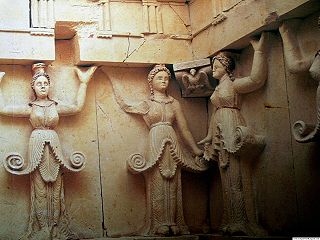
The Thracian Tomb of Svestari is 2.5 kilometers (1.6 mi) southwest of the village of Sveshtari, Razgrad Province, which is 42 kilometers (26 mi) northeast of Razgrad, in northeast Bulgaria. The tomb is probably the grave of Dromichaetes who was a king of the Getae on both sides of the lower Danube around 300 BCE, and his wife, the daughter of King Lysimachus who was a general and diadochus of Alexander the Great. The tomb is a UNESCO World Heritage Site.

The Thracian Tomb of Kazanlak is a vaulted-brickwork "beehive" (tholos) tomb that is located near the town of Kazanlak in central Bulgaria.

Georgi Kitov was a Bulgarian archaeologist and thracologist. He specialized in Thracian archaeology. He participated in the excavations of many sites including the Alexandrovo Tomb, Kosmatka, Svetitzata and Starosel Cult Complex.

KV20 is a tomb in the Valley of the Kings (Egypt). It was probably the first royal tomb to be constructed in the valley. KV20 was the original burial place of Thutmose I and later was adapted by his daughter Hatshepsut to accommodate her and her father. The tomb was known to Napoleon Bonaparte's expedition in 1799 and had been visited by several explorers between 1799 and 1903. A full clearance of the tomb was undertaken by Howard Carter in 1903–1904. KV20 is distinguishable from other tombs in the valley, both in its general layout and because of the atypical clockwise curvature of its corridors.

The pyramid of Unas is a smooth-sided pyramid built in the 24th century BC for the Egyptian pharaoh Unas, the ninth and final king of the Fifth Dynasty. It is the smallest Old Kingdom pyramid, but significant due to the discovery of Pyramid Texts, spells for the king's afterlife incised into the walls of its subterranean chambers. Inscribed for the first time in Unas's pyramid, the tradition of funerary texts carried on in the pyramids of subsequent rulers, through to the end of the Old Kingdom, and into the Middle Kingdom through the Coffin Texts that form the basis of the Book of the Dead.

Seuthes III was a king of Odrysia, a part of Thrace, during the late 4th century BC.

The Aleksandrovo tomb is a Thracian burial mound and tomb excavated near Aleksandrovo, Haskovo Province, South-Eastern Bulgaria, dated to c. 4th century BCE.
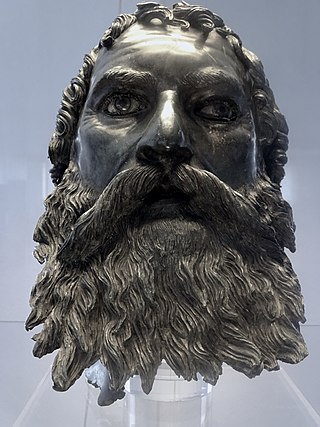
The Tomb of Seuthes III is located near Kazanlak, Bulgaria. Seuthes III was the King of the Odrysian Kingdom of Thrace from c. 331 to c. 300 BC and founder of the nearby Thracian city of Seuthopolis.

The Ostrusha mound is a Thracian burial tumulus near the Bulgarian town of Shipka. It was constructed in the middle of the 4th century BCE. The stone structures under the more than 18 meters high mound form one of the biggest representative tomb-cult complexes with 6 rooms on an area of 100 square meters. It was professionally excavated in 1993.
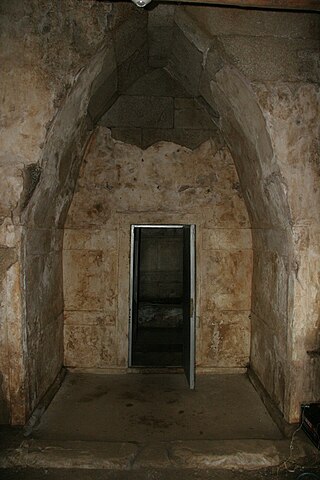
The Thracian tomb "Helvetia" mound near Shipka, Bulgaria, was built in the middle of the 4th century BC.

Golyama Arsenalka mound is a Thracian burial tumulus with a subterranean stone building near the Bulgarian town of Shipka. It dates from the end of 5th century BCE.
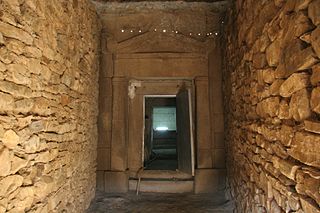
The Thracian tomb Griffins, found in Bulgaria, has a façade decorated with plastic columns and with a pediment above them. The pediment`s ends are semi-palmettes, the lower leaves of which are elongated and look like heads of griffins. The temple was built in the 5th century BC. There is a corridor made from river stones, floored with earth. The façade, the antechamber and the circular chamber are built of granite blocks. The entrances to the antechamber and the dome chamber had been closed by stone doors which were found broken during the research of the facility. The antechamber is of rectangular shape and has a double-pitched roof. The round chamber is covered with fine-made dome. The floors of both rooms are made of plastered granite slabs. Opposite the entrance of the circular chamber is situated a ritual stone bed with decorations. On a stone block in front of the bed were found gold paws. A funeral took place in the temple in the 4th century BC. The corridor was filled with river stones and soil. It was robbed in antiquity.

The Valley of the Thracian Rulers is a name which was made popular by the archaeologist Georgi Kitov and describes the extremely high concentration and variety of monuments of the Thracian culture in the Kazanlak Valley in Bulgaria. It is believed that there are over 1500 tumuli in the region, with only 300 being researched so far.
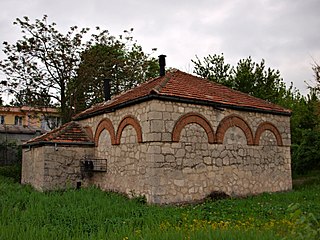
The Roman Tomb of Silistra is an Ancient Roman burial tomb in the town of Silistra in northeastern Bulgaria. Dating to the mid-4th century AD, the Roman Tomb is the best-preserved architectural monument of the Ancient Roman city of Durostorum. The tomb is considered "one of the most investigated and most discussed monuments of the late antique art in Bulgaria" and the Balkans, owing in large part to the quality and extent of its interior frescoes.

The pyramid of Nyuserre is a mid-25th-century BC pyramid complex built for the Egyptian pharaoh Nyuserre Ini of the Fifth Dynasty. During his reign, Nyuserre had the unfinished monuments of his father, Neferirkare Kakai, mother, Khentkaus II, and brother, Neferefre, completed, before commencing work on his personal pyramid complex. He chose a site in the Abusir necropolis between the complexes of Neferirkare and Sahure, which, restrictive in area and terrain, economized the costs of labour and material. Nyuserre was the last king to be entombed in the necropolis; his successors chose to be buried elsewhere. His monument encompasses a main pyramid, a mortuary temple, a valley temple on Abusir Lake, a causeway originally intended for Neferirkare's monument, and a cult pyramid.

The Mogilan mound or Mogilanska mound is a burial mound in the center of Vratsa, Bulgaria.





















